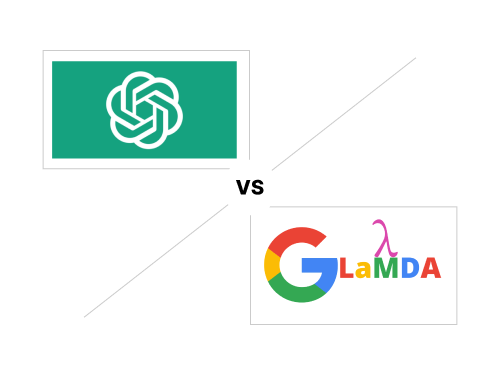Revolutionizing Natural Language Processing: ChatGPT and Google LaMDA Leading the Way

Artificial Intelligence (AI) has been a rapidly growing field in recent years, and one of its branches, Natural Language Processing (NLP), has seen significant advancements. The development of language models like ChatGPT and Google's LaMDA has pushed the boundaries of what is possible in NLP, and these models are set to have a profound impact on how we interact with computers in the years to come.
ChatGPT: A Breakthrough in Conversational AI
Using a massive corpus of text data, OpenAI developed ChatGPT, a transformer-based language model. This diverse training data includes a wide range of topics and conversation styles, allowing ChatGPT to understand the context and respond in a natural, human-like manner. This model is one of the first of its kind to be able to understand the context and respond appropriately, which is a huge step forward in the field of NLP.
ChatGPT's ability to understand context is crucial for the development of conversational AI. Conversational AI is a rapidly growing field, and ChatGPT has the potential to revolutionize how we interact with computers. With its ability to respond in a professional, informal, or even humorous manner, depending on the context of the conversation, ChatGPT opens up new opportunities for conversational AI applications in areas such as customer service, marketing, and entertainment.
One of the key benefits of ChatGPT is its versatility. The model's deep understanding of how language is used in different contexts has allowed it to generate responses that are appropriate to the situation. This versatility makes ChatGPT a valuable tool for a wide range of applications, and its ability to understand the context and respond in a human-like manner sets it apart from other language models.
ChatGPT is a conversational language model developed by OpenAI that has the following functionalities:
-
Question Answering: ChatGPT can generate answers to questions, including factual and opinion-based queries, based on its vast knowledge base.
-
Dialogue Generation: It can generate human-like text responses in natural language and engage in multi-turn conversations on a wide range of topics.
-
Text Completion: ChatGPT can complete partial sentences or paragraphs, predicting the most likely continuation of the text.
-
Text Summarization: It can generate concise summaries of longer texts, making it useful for summarizing articles, reports, and other long-form documents.
-
Text Generation: ChatGPT can generate new text based on a given input, such as generating headlines, captions, or story endings.
-
Sentiment Analysis: ChatGPT can detect the sentiment of a given text, such as whether it is positive, negative, or neutral.
Google's LaMDA: Pushing the Boundaries of NLP
Google's LaMDA (Language Model for Dialogue Applications) is another transformer-based model developed by Google Research. LaMDA has been trained on a massive corpus of text data, including conversations, news articles, and other types of text. This allows LaMDA to generate text that is context-aware and specific to a particular scenario or application.
One of the critical advantages of LaMDA is its ability to generate text that is diverse and creative. The model's diverse training data has allowed it to learn how to generate text that is both informative and engaging, opening up new opportunities for NLP applications in entertainment and marketing. LaMDA's ability to generate text in multiple languages is another advantage, making it easier to translate text between languages and expanding the scope of NLP applications in countries where multiple languages are spoken.
LaMDA's ability to generate context-aware text is crucial for the development of NLP applications. With its ability to generate text that is specific to a particular scenario or application, LaMDA opens up new opportunities for NLP in areas such as customer service, marketing, and entertainment. The model's diverse training data has allowed it to learn how to generate text that is both informative and engaging, which is a significant step forward in the field of NLP.
Google LaMDA has the following functionalities:
- Question Answering: It can generate answers to a wide range of questions, including factual and opinion-based queries.
-
Dialogue Generation: LaMDA can generate multi-turn conversations on a wide range of topics, allowing users to engage in natural language exchanges.
-
Text Completion: It can complete partial sentences or paragraphs by predicting the most likely continuation of the text.
-
Text Summarization: LaMDA can generate concise summaries of longer texts, making it useful for summarizing articles, reports, and other long-form documents.
-
Text Generation: It can generate new text based on a given input, such as generating headlines, captions, or story endings.
Specific examples of the applications of ChatGPT and LaMDA can include:
- Customer service: ChatGPT and LaMDA can be used to power conversational AI systems that can assist customers with their queries and provide support. For example, a customer service chatbot powered by ChatGPT can answer questions related to a company's products or services, and provide relevant information to the customer.
- Entertainment: ChatGPT and LaMDA can also be used to generate content in the entertainment industry. For example, a game powered by LaMDA can generate unique and imaginative storylines, characters, and settings on-the-fly, providing endless hours of fun and entertainment.
- News and journalism: ChatGPT and LaMDA can be used to generate news articles and reports in real-time, providing up-to-date information on events happening around the world. For example, a news organization can use ChatGPT to generate reports on breaking news, providing real-time updates to its audience.
- Healthcare: ChatGPT and LaMDA can also be used to provide medical information and support to patients. For example, a healthcare chatbot powered by ChatGPT can provide information on symptoms, treatments, and health conditions, helping patients make informed decisions about their health.
- Business and finance: ChatGPT and LaMDA can be used to analyze large amounts of financial data and provide insights to traders and investors. For example, a financial analysis tool powered by LaMDA can generate reports on market trends, providing valuable information to traders and investors.
These are just a few examples of the many potential applications of ChatGPT and LaMDA, and as the models continue to improve, the possibilities are only going to grow. The impact of these models on a wide range of industries is truly exciting, and we can expect to see many more innovative uses for them in the years to come.
Challenges & Limitations
Despite the advancements made by ChatGPT and LaMDA, there are still challenges and limitations that need to be addressed in the field of NLP. One of the main challenges is ensuring that language models like ChatGPT and LaMDA are not biased. The models are trained on massive amounts of text data, and if that data is biased in any way, the models will be too. To ensure that the models are not biased, it is important to carefully curate the training data and to include a diverse range of perspectives and opinions.
Another challenge is ensuring that the models generate text that is coherent and makes sense. This can be a problem because the models are not always able to understand the context of the conversation or the scenario in which they are being used. In some cases, the models may generate text that is nonsensical or off-topic, which can be confusing for users. To overcome this challenge, developers need to implement algorithms that can detect and correct these issues, and ensure that the models generate text that is coherent and makes sense.
There are also limitations in the level of creativity and originality of the text generated by these models. The models are trained on a large corpus of text data, but they still rely on the training data to generate text. This means that the models are limited by the quality and diversity of the training data, and may not be able to generate text that is truly original or creative. To overcome this limitation, researchers need to continue to develop new training data and improve the quality and diversity of the data used to train these models.
Google LaMDA and OpenAI's ChatGPT are both advanced language models that can be incredibly useful for developers in various industries.
-
Natural Language Processing: Both models are trained on a vast amount of text data and can be used to support a wide range of natural languages processing tasks, such as question answering, text completion, and sentiment analysis. This makes them valuable tools for developing language-based applications and improving the accuracy of existing ones.
-
Conversational AI: LaMDA and ChatGPT are designed to generate human-like text responses and engage in multi-turn conversations, making them ideal for powering conversational AI applications, such as chatbots and voice assistants. They can help businesses to improve customer engagement and support, as well as streamline customer service operations.
-
Text Generation: Both models have the ability to generate new text based on a given input, such as headlines, captions, and story endings. This can be useful for a wide range of applications, including content creation, information retrieval, and marketing.
-
Personalization: LaMDA and ChatGPT can be trained in specific domains, such as customer service, healthcare, or finance, to improve their performance in these particular areas. This allows developers to create highly personalized and domain-specific conversational AI applications that can better serve their target audiences.
CONCLUSION
ChatGPT and LaMDA are two of the most advanced language models currently available, and their ability to understand the context and generate context-aware text is a significant step forward in the field of NLP. These models have the potential to revolutionize the way we interact with computers and have a profound impact on a wide range of applications, from customer service to entertainment.
However, there are still challenges and limitations that need to be addressed in the field of NLP, and researchers need to continue to work on improving the quality and versatility of these models. Despite these challenges, the advancements made by ChatGPT and LaMDA are a testament to the incredible progress that has been made in the field of NLP and the exciting potential for what is yet to come.














